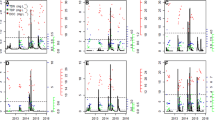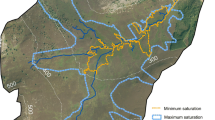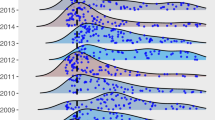Abstract
We examined the influence of watershed land use and morphology on dissolved organic carbon (DOC) concentration in 32 south-central Ontario streams having varying agricultural land-use intensities in their catchments. For streams in this region, both univariate and multivariate regression models identify the proportion of the watershed with poorly drained soils (r 2 up to 0.67) as a better predictor of stream DOC concentrations than any other landscape characteristic, including the proportion of the watershed as wetland. Agricultural land use did not strongly influence DOC concentrations in our study area; however, we do show that land-use changes could significantly alter the delivery of DOC to streams in the region. We also identify how landscape–DOC relationships change over a 2-year time period, as related to season, regional climatic conditions, soil moisture, and hydrology. Our results indicate that the relationships between landscape predictors and stream DOC concentrations are temporally dynamic. Strong temporal trends are shown seasonally and in association with climate, through its control of modelled soil moisture conditions. During periods of positive and negative deviation from normal soil moisture conditions, the relationships of DOC concentrations with landscape characteristics become less predictable. We show that these dominant patterns are likely a function of varying flow paths and that anthropogenic changes that affect soil moisture conditions or flow path will in turn strongly influence DOC dynamics.








Similar content being viewed by others
REFERENCES
Agriculture and Agri-Food Canada 2002. National Soil Database: detailed soil surveys. Ottawa: Agriculture and Agri-Food Canada
Agriculture and Agri-Food Canada. 2007. Prarie Farm Rehabilitation Association drought watch dataset. Regina: Agriculture and Agri-Food Canada, PFRA
Aitkenhead JA, McDowell WH 2000. Soil C:N ratio as a predictor of annual riverine DOC flux at local and global scales. Global Biogeochem Cycles 14:127–38
Aitkenhead-Peterson JA, McDowell WH, Neff JC 2003. Sources, production, and regulation of allochthonous dissolved organic matter inputs to surface waters. In: Findlay SEG, Sinsabaugh RL, Eds. Aquatic ecosystems: interactivity of dissolved organic matter. Boston: Academic Press. pp 26–59
Belsley DA, Kuh E, Welsch RE 1980. Regression diagnostics: identifying influential data and sources of collinearity. New York: John Wiley and Sons
Bernhardte ES, Likens GE 2002. Dissolved organic carbon enrichment alters nitrogen dynamics in a forest stream. Ecology 83(6):1689–700
Creed LF, Sanford SE, Beall FD, Molot LA, Dillon PJ 2003. Cryptic wetlands: integrating hidden wetlands in regression models of the export of dissolved organic carbon from forested landscapes. Hydrol Processes 17:3629–48
Cronan CS, Piampiano JT, Patterson HH 1999. Influence of land use and hydrology on exports of carbon and nitrogen in a Maine River Basin. J Environ Qual 28(3):953–61
Curtis P, Schindler D 1997. Hydrologic control of dissolved organic matter in low-order Precambrian Shield lakes. Biogeochemistry 36(1):125–8
Dalva M, Moore TR 1991. Sources and sinks of dissolved organic-carbon in a forested swamp catchment. Biogeochemistry 15(1):1–19
Dalzell BJ, Filley TR, Harbor JM 2007. The role of hydrology in annual organic carbon loads and terrestrial organic matter export from a midwestern agricultural watershed. Geochimica Et Cosmochimica Acta 71(6):1448–62
Dillon PJ, Molot LA 1997. Effect of landscape form on export of dissolved organic carbon, iron, and phosphorus from forested stream catchments. Water Resour Res 33(11):2591–600
Dunne T, Leopold LB. 1978. Water in environmental planning. San Francisco: W.H. Freeman and Company. 818 pp
Eckhardt BW, Moore TR 1990. Controls on dissolved organic carbon concentrations in streams, southern Quebec. Can J Fish Aquat Sci 47(8):1537–44
ESRI 2004. ArcMap 9.0. Version build 538. Redlands, California: Environmental Systems Resource Institute
Frost PC, Larson JH, Johnston CA, Young KC, Maurice PA, Lamberti GA, Bridgham SD 2006. Landscape predictors of stream dissolved organic matter concentration and physiochemistry in a Lake Superior river watershed. Aquat Sci 68:40–51
Gergel SE, Turner MG, Krats TK 1999. Dissolved organic carbon as an indicator of the scale of watershed influences on lakes and rivers. Ecol Appl 9(4):1377–90
Gorham E, Underwood JK, Janssens JA, Freedmam B, Maass W, Waller DH, Ogden JG 1998. The chemistry of streams in south-western and central Nova Scotia, with particular reference to catchment vegetation and the influence of dissolved organic carbon primarily from wetlands. Wetlands 18(1):115–32
Hinton MJ, Schiff SL, English MC 1997. The significance of storms for the concentration and export of dissolved organic carbon from two Precambrian Shield catchments. Biogeochemistry 36(1):67–88
Hope D, Billett MF, Cresser MS 1994. A review of the export of carbon in river water—fluxes and processes. Environ Pollut 84(3):301–24
Hornberger GM, Bencala KE, McKnight DM 1994. Hydrological controls on dissolved organic-carbon during snowmelt in the Snake River near Montezuma, Colorado. Biogeochemistry 25(3):147–165
Hornberger GM, Bencala KE, McKnight DM 1995. Hydrological controls on dissolved organic carbon during snowmelt in the Snake River near Motezuma, Colorado. Biogeochemistry 25:147–65
Marmonier P, Fontvieille D, Gibert J, Vanek V 1995. Distribution of dissolved organic carbon and bacteria at the interface between the Rhone River and its alluvial aquifer. J North Am Benthol Soc 14(3):382–92
Metcalfe RA, Schmidt B, Pyrce R 2005. A surface water quality threats assessment method using landscape-based indexing. Peterborough, Ontario: Watershed Science Centre
Moore TR. 2003. Dissolved organic carbon in a northern boreal landscape. Global Biogeochem Cycles 17(4):Art. No. 1109
Moore TR, Trofymow JA, Taylor B, Prescott C, Camire C, Duschene L, Fyles J, Kozak L, Kranabetter M, Morrison I and others 1999. Litter decomposition rates in Canadian forests. Global Change Biol 5(1):75–82
Morris DP, Zagarese H, Williamson C, Balseiro E, Hargreaves B, Modenutti B, Moeller R, Queimalinos C 1995. The attenuation of solar UV radiation in lakes and the role of dissolved organic carbon. Limnol Oceanogr 40(8):1381–91
Mulholland PJ 1997. Dissolved organic matter concentration and flux in streams. J North Am Benthol Soc 16(1):131–41
Mulholland PJ, Hill WR 1997. Seasonal patterns of in stream water nutrient and dissolved organic carbon concentrations: separating catchment flow path and in-stream effects. Water Resour Res 33:1297–306
Ontario Ministry of Agriculture, Food. 2004. Soils Ontario packaged product (soils ON). Peterborough: Ontario Ministry of Agriculture and Food
Ontario Ministry of Natural Resources 2002a. Provincial digital elevation model—tiled data set. Peterborough: Ontario Ministry of Natural Resources, Water Resources Information Project
Ontario Ministry of Natural Resources 2002b. Water resources information project, stream networks. Peterborough: Ontario Ministry of Natural Resources, Water Resources Information Project
Ontario Ministry of Natural Resources 2007. Southern Ontario Interim landcover. Peterborough: Ontario Ministry of Natural Resources, Geographic Information Branch
Palmer W 1968. Keeping track of crop moisture conditions nationwide: the new crop moisture index. Weatherwise 21:156–61
Post WM, Kwon KC 2000. Soil carbon sequestration and land-use change: processes and potential. Global Change Biol 6(3):317–27
Royer TV, David MB 2005. Export of dissolved organic carbon from agricultural streams in Illinois, USA. Aquat Sci 67(4):465–71
SAS Institute Inc 2001. SAS for Windows. Version 8.2. Cary, NC: Statistical Analysis Systems Institute Inc
Schiff SL, Avena R, Trumbore SE, Hinton MJ, Elgood R, Dillon PJ 1997. Export of DOC from forested catchments on the Precambrian Shield of Central Ontario: clues from 13C and 14C. Biogeochemistry 36(11):43–65
Singer SN, Cheng CK, Scafe MG 2003. The hydrogeology of southern Ontario, 2nd edn. Toronto: Ministry of the Environment
Singh VP 1992. Elementary hydrology. Upper Saddle River, New Jersey: Prentice Hall
Skaggs RW, Breve MA, Gilliam JW 1994. Hydrologic and water-quality impacts of agricultural drainage. Crit Rev Environ Sci Technol 24(1):1–32
Sobek S, Tranvik LJ, Prairie YT, Kortelainen P, Cole JJ 2007. Patterns and regulation of dissolved organic carbon: an analysis of 7,500 widely distributed lakes. Limnol Oceanogr 52(3):1208–19
Thurman EM 1985. Organic geochemistry of natural waters. Boston: Dr. W. Junk Publishers. 497 pp
Wetzel RG 2001. Limnology, lake and river ecosystems. San Deigo: Academic Press
Xenopoulos MA, Schindler DW. 2001. Physical factors determining ultraviolet radiation flux in ecosystems. In: Cockell CS, Blaustein AR, Eds. Ecosystems, evolution and ultraviolet radiation. New York: Springer. pp 36–62
Xenopoulos MA, Lodge DM, Frentress J, Kreps TA, bridgham SD, Grossman E, Jackson CJ 2003. Regional comparisons of watershed determinants of dissolved organic carbon in temperate lakes from the Upper Great Lakes region and selected regions globally. Limnol Oceanogr 48(6):2321–34
Acknowledgments
Many field and technical assistants have helped us in collecting and processing the data. We thank L. James, K. Warren, J. Norman, J. Plourde, M. Kingsbury, R. Kelly for their assistance in the field and in the lab. This research was supported by Canada’s Natural Sciences Research and Engineering Research Council (NSERC) Discovery grant to M. A. Xenopoulos, NSERC University Faculty Award to M. A. Xenopoulos, and NSERC postgraduate scholarships to H. F. Wilson.
Author information
Authors and Affiliations
Corresponding author
Electronic supplementary material
Below is the link to the electronic supplementary material.
Appendix 1
Detailed landscape characterizations for 32 study watersheds in the south-central Ontario region
(DOC 8 kb)
Rights and permissions
About this article
Cite this article
Wilson, H.F., Xenopoulos, M.A. Ecosystem and Seasonal Control of Stream Dissolved Organic Carbon Along a Gradient of Land Use. Ecosystems 11, 555–568 (2008). https://doi.org/10.1007/s10021-008-9142-3
Received:
Revised:
Accepted:
Published:
Issue Date:
DOI: https://doi.org/10.1007/s10021-008-9142-3




